Roden 1/48 Sopwith 1 1/2 Strutters | 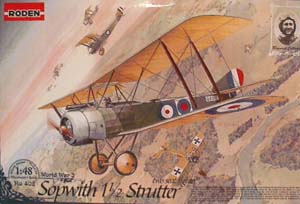 | INTRODUCTION: 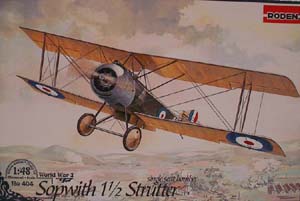 This is a kit I didn't think I would ever see in 1/48 scale. Then again, I have been saying that a lot lately with all the new World War I kits that have been coming out. The Strutter (named for the long "W" shaped cabane struts) was a development of a 1915 design by the Sopwith Aviation Company. It came in both a single seat and two seat configuration and was known by the Sopwith Company as the Sopwith LCT (Land Clerget Tractor). This is a kit I didn't think I would ever see in 1/48 scale. Then again, I have been saying that a lot lately with all the new World War I kits that have been coming out. The Strutter (named for the long "W" shaped cabane struts) was a development of a 1915 design by the Sopwith Aviation Company. It came in both a single seat and two seat configuration and was known by the Sopwith Company as the Sopwith LCT (Land Clerget Tractor). The Strutter was produced in England by: Sopwith; Mann, Egerton & Company; Ruston Proctor & Co. Ltd.; Morgan & Co.; Wells Aviation Co.; Fairey; Vickers and Westland Aircraft Works and in France by 12 firms, including Hanriot, Nieuport, and Salmson. In fact, more Strutters were produced in France than in England. Strutters were used by the English, French, Dutch, Belgian, Japanese, Russian and American air services. THE KITS: 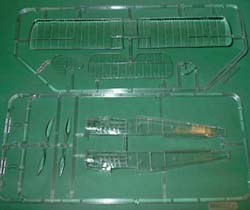 Roden has produced two versions of the Strutter, a single seat bomber (kit # 404) and a two seat fighter (kit #402). The kits themselves look really weird, with the wings, rudder, tailplane, propeller (two choices), turtledeck and fuselage all being done in clear plastic. Not too much flash, but what there is seems pretty brittle. I haven't tried to trim it yet, so maybe I'm wrong. You get 2 choices for the top wing. Both are in clear plastic. There are no resin parts. The rest of the parts are on four sprues of light gray plastic. You get extra machine guns in both kits: four Lewis guns and two Vickers guns in each kit. four small bombs are also included in both kits. Each kit has a photoetch set with a really nice looking� instrument panel. Roden has produced two versions of the Strutter, a single seat bomber (kit # 404) and a two seat fighter (kit #402). The kits themselves look really weird, with the wings, rudder, tailplane, propeller (two choices), turtledeck and fuselage all being done in clear plastic. Not too much flash, but what there is seems pretty brittle. I haven't tried to trim it yet, so maybe I'm wrong. You get 2 choices for the top wing. Both are in clear plastic. There are no resin parts. The rest of the parts are on four sprues of light gray plastic. You get extra machine guns in both kits: four Lewis guns and two Vickers guns in each kit. four small bombs are also included in both kits. Each kit has a photoetch set with a really nice looking� instrument panel. 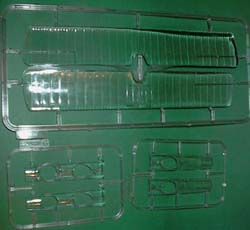 The fuselage has some interior detail molded on it. As far as scale accuracy is concerned, I placed the major parts against the plans by I.R. Stair in Datafile #34. One advantage of the clear plastic is that it makes it easy to compare the parts to the drawings just lay them on top! The fuselage and rudder seem pretty accurate. The top wing (either version), lower wing and tailplane all are a bit too long. The fuselage has some interior detail molded on it. As far as scale accuracy is concerned, I placed the major parts against the plans by I.R. Stair in Datafile #34. One advantage of the clear plastic is that it makes it easy to compare the parts to the drawings just lay them on top! The fuselage and rudder seem pretty accurate. The top wing (either version), lower wing and tailplane all are a bit too long. The channels leading into the struts are rather thick, so some cleanup will be required. The landing gear looks nice and shouldn't require much sanding. I didn't try to dry fit any of the pieces, so I can't comment on this. The instructions are in the form of drawings without text showing the location of parts and sequence in which to build the kit. A rigging diagram and decal instruction for the four versions of each kit completes the contents. THE SINGLE SEAT BOMBER KIT 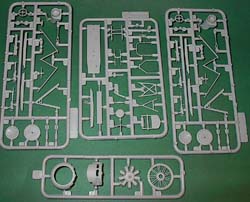 This kit comes with four sets of decals, N 5134 with the Aviation�Militaire, N 5115 from No. 3 Wing RNAS, with No. 2 Wing�RNAS and 9706 with No. 3 Wing RNAS. The decals are in register although the blue on the French decals seems too bright for my tastes. There are also some "Lift Here" arrows provided. The sheet also contains stencils that aren't on the 2-seater, for Mann-Egerton, Sopwith Aviation Co. and Westland Aircraft Works. This kit comes with four sets of decals, N 5134 with the Aviation�Militaire, N 5115 from No. 3 Wing RNAS, with No. 2 Wing�RNAS and 9706 with No. 3 Wing RNAS. The decals are in register although the blue on the French decals seems too bright for my tastes. There are also some "Lift Here" arrows provided. The sheet also contains stencils that aren't on the 2-seater, for Mann-Egerton, Sopwith Aviation Co. and Westland Aircraft Works. There are two different choices for the turtledeck, but both have a single cockpit opening. There are also two choices for the top wing. Some of the top wings had the center section left clear and some were completely covered with fabric. Your choice of subject will determine which wing you use. �TWO SEAT FIGHTER KIT  This kit comes in a box with Raymond Collishaw's photo in corner and markings for his No. 3 Wing Strutter along with three other sets of decals: 70 Sq. Lt. Gotch, Esc. Sop 29 and Esc. Sop 226. The RNAS and RFC planes are in PC-10 over CDL and the French are indicated as being CD – note that there is some recent research indicating that French Strutters were actually finished in aluminum. You have a choice in turtledecks, either a rounded observer's opening or a slightly oval one. Check your references to determine which one is right for you. This kit comes in a box with Raymond Collishaw's photo in corner and markings for his No. 3 Wing Strutter along with three other sets of decals: 70 Sq. Lt. Gotch, Esc. Sop 29 and Esc. Sop 226. The RNAS and RFC planes are in PC-10 over CDL and the French are indicated as being CD – note that there is some recent research indicating that French Strutters were actually finished in aluminum. You have a choice in turtledecks, either a rounded observer's opening or a slightly oval one. Check your references to determine which one is right for you. CONCLUSION This is a great subject for a kit. The boxes open from the top, not from the sides, removing one of my pet peeves. I would have preferred that the top wing without the clear center section would have been done in the same light gray plastic used for some of the other parts. For that matter, I also wish they hadn't used the clear plastic for the fuselage, etc. These are small points and I can't wait to build my Strutter. | 







|

 This is a kit I didn't think I would ever see in 1/48 scale. Then again, I have been saying that a lot lately with all the new World War I kits that have been coming out. The Strutter (named for the long "W" shaped cabane struts) was a development of a 1915 design by the Sopwith Aviation Company. It came in both a single seat and two seat configuration and was known by the Sopwith Company as the Sopwith LCT (Land Clerget Tractor).
This is a kit I didn't think I would ever see in 1/48 scale. Then again, I have been saying that a lot lately with all the new World War I kits that have been coming out. The Strutter (named for the long "W" shaped cabane struts) was a development of a 1915 design by the Sopwith Aviation Company. It came in both a single seat and two seat configuration and was known by the Sopwith Company as the Sopwith LCT (Land Clerget Tractor).  Roden has produced two versions of the Strutter, a single seat bomber (kit # 404) and a two seat fighter (kit #402). The kits themselves look really weird, with the wings, rudder, tailplane, propeller (two choices), turtledeck and fuselage all being done in clear plastic. Not too much flash, but what there is seems pretty brittle. I haven't tried to trim it yet, so maybe I'm wrong. You get 2 choices for the top wing. Both are in clear plastic. There are no resin parts. The rest of the parts are on four sprues of light gray plastic. You get extra machine guns in both kits: four Lewis guns and two Vickers guns in each kit. four small bombs are also included in both kits. Each kit has a photoetch set with a really nice looking
instrument panel.
Roden has produced two versions of the Strutter, a single seat bomber (kit # 404) and a two seat fighter (kit #402). The kits themselves look really weird, with the wings, rudder, tailplane, propeller (two choices), turtledeck and fuselage all being done in clear plastic. Not too much flash, but what there is seems pretty brittle. I haven't tried to trim it yet, so maybe I'm wrong. You get 2 choices for the top wing. Both are in clear plastic. There are no resin parts. The rest of the parts are on four sprues of light gray plastic. You get extra machine guns in both kits: four Lewis guns and two Vickers guns in each kit. four small bombs are also included in both kits. Each kit has a photoetch set with a really nice looking
instrument panel. The fuselage has some interior detail molded on it. As far as scale accuracy is concerned, I placed the major parts against the plans by I.R. Stair in Datafile #34. One advantage of the clear plastic is that it makes it easy to compare the parts to the drawings just lay them on top! The fuselage and rudder seem pretty accurate. The top wing (either version), lower wing and tailplane all are a bit too long.
The fuselage has some interior detail molded on it. As far as scale accuracy is concerned, I placed the major parts against the plans by I.R. Stair in Datafile #34. One advantage of the clear plastic is that it makes it easy to compare the parts to the drawings just lay them on top! The fuselage and rudder seem pretty accurate. The top wing (either version), lower wing and tailplane all are a bit too long.  This kit comes with four sets of decals, N 5134 with the Aviation
Militaire, N 5115 from No. 3 Wing RNAS, with No. 2 Wing
RNAS and 9706 with No. 3 Wing RNAS. The decals are in register although the blue on the French decals seems too bright for my tastes. There are also some "Lift Here" arrows provided. The sheet also contains stencils that aren't on the 2-seater, for Mann-Egerton, Sopwith Aviation Co. and Westland Aircraft Works.
This kit comes with four sets of decals, N 5134 with the Aviation
Militaire, N 5115 from No. 3 Wing RNAS, with No. 2 Wing
RNAS and 9706 with No. 3 Wing RNAS. The decals are in register although the blue on the French decals seems too bright for my tastes. There are also some "Lift Here" arrows provided. The sheet also contains stencils that aren't on the 2-seater, for Mann-Egerton, Sopwith Aviation Co. and Westland Aircraft Works. This kit comes in a box with Raymond Collishaw's photo in corner and markings for his No. 3 Wing Strutter along with three other sets of decals: 70 Sq. Lt. Gotch, Esc. Sop 29 and Esc. Sop 226. The RNAS and RFC planes are in PC-10 over CDL and the French are indicated as being CD – note that there is some recent research indicating that French Strutters were actually finished in aluminum. You have a choice in turtledecks, either a rounded observer's opening or a slightly oval one. Check your references to determine which one is right for you.
This kit comes in a box with Raymond Collishaw's photo in corner and markings for his No. 3 Wing Strutter along with three other sets of decals: 70 Sq. Lt. Gotch, Esc. Sop 29 and Esc. Sop 226. The RNAS and RFC planes are in PC-10 over CDL and the French are indicated as being CD – note that there is some recent research indicating that French Strutters were actually finished in aluminum. You have a choice in turtledecks, either a rounded observer's opening or a slightly oval one. Check your references to determine which one is right for you. 






